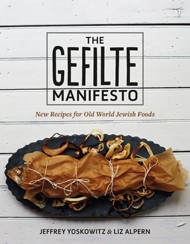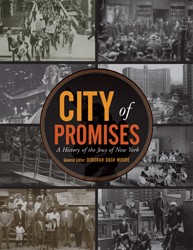Together with Liz Alpern, Jeffrey Yoskowitz is both co-founder of The Gefilteria and co-author of The Gefilte Manifesto: New Recipes for Old World Jewish Foods. With the cookbook’s long-awaited release this week, Jeffrey and Liz are guest blogging for the Jewish Book Council as part of the Visiting Scribe series here on The ProsenPeople.
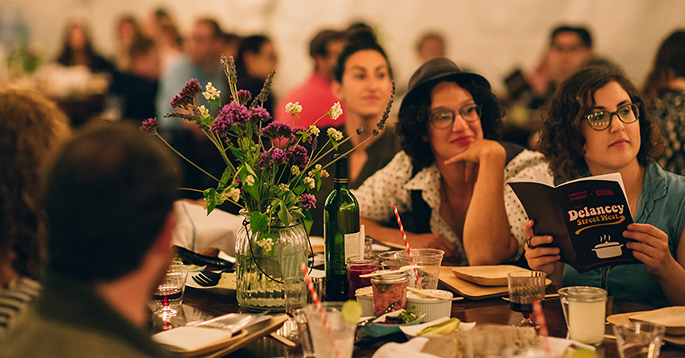 Images by Stacy Keck, provided courtesy of Leichtag Commons
Images by Stacy Keck, provided courtesy of Leichtag Commons
Writing an Ashkenazi cookbook while living in New York makes a lot of sense. New York City is the epicenter of Jewish deli culture and American Jewish life, after all. It’s the home of the largest smoked fish purveyor in the country, Knish Alley (an old moniker for Second Avenue), bagel and bialy bakeries, and a serious legacy of Jewish pickling.
And yet, as I dug deep into the history of Ashkenazi Jewish food from the old country, it became clear that the connection to the land, once such an important part of Jewish culinary life, had proven difficult to translate to the bustling urban world I live in today. My own grandmother, who grew up in the village of Szumsk in Poland (now Ukraine), used to pluck plums from the trees in her yard, milk the family cow daily, and turn local cabbage into sauerkraut every fall. When she came to the United States, she bought matzo meal instead of crushing her own from freshly baked matzos, used store-bought farmer cheese instead of curdling her own, and replaced homemade plum preserves with store-bought varieties. She always lamented the lack of good butter in the United States.
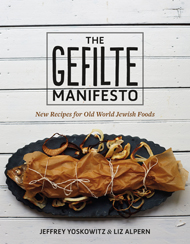 When I set out to write the narrative cookbook The Gefilte Manifesto with Liz Alpern—my business partner at The Gefilteria, our Brooklyn-based culinary venture that reimagines eastern European Jewish foods — I wanted to better understand a bit of what it meant to cook and eat foods from Poland and Russia and Lithuania before the dishes were adapted to North American tastes. Sure, I was also interested in more deeply exploring the Jewish-American traditions I’m so fond of, such as classic dishes from the delis and appetizing shops, but I felt from my grandmother’s stories and my own family experiences that there was a deeper wisdom behind the cuisine — as well as a lighter side — to the foods that defined my cultural identity. Part of what was missing in New York, I realized, was proximity to the land and to the rhythm of the seasons.
When I set out to write the narrative cookbook The Gefilte Manifesto with Liz Alpern—my business partner at The Gefilteria, our Brooklyn-based culinary venture that reimagines eastern European Jewish foods — I wanted to better understand a bit of what it meant to cook and eat foods from Poland and Russia and Lithuania before the dishes were adapted to North American tastes. Sure, I was also interested in more deeply exploring the Jewish-American traditions I’m so fond of, such as classic dishes from the delis and appetizing shops, but I felt from my grandmother’s stories and my own family experiences that there was a deeper wisdom behind the cuisine — as well as a lighter side — to the foods that defined my cultural identity. Part of what was missing in New York, I realized, was proximity to the land and to the rhythm of the seasons.
The urge to recreate the idyllic picture of shtetl cookery certainly inspired my three-week stay this summer at Leichtag Commons, just outside of San Diego, California. The property is home to a vibrant hub of Jewish communal organizations, as well as the incredible Coastal Roots Farm.
The Gefilteria was brought in for a three-week culinary residency — the first of its kind for the community (and for us!). The goal was to bring our philosophy and approach to Ashkenazi cuisine to as unlikely a place as Encinitas, California. It almost felt preposterous to be making eastern European foods like fresh “curd-to-crepe” blintzes and buckwheat breads while surrounded by citrus trees and cacti.
Yet it also kind of made sense. From the moment we arrived and set up shop in the kitchen, which overlooked the fields, farmers began arriving with crates of vegetables. “Anything you can do with these?” they asked, holding out a bushel of extraordinarily perfect pickling cucumbers. As a pickler who got started on a Jewish pickle farm, I hadn’t seen such great cukes in a long time. I was in heaven. We immediately threw down three or four batches of classic sour dills.

As the weeks wore on, we taught cooking classes and cooked and planned for huge meals, all the while turning freshly picked strawberries into syrups and jams, local raw cream and milk into farmer cheese, sour cream and butter. We harvested sorrel leaves to make schav, a sorrel soup also sometimes called green borscht. In other words, I would have made my grandmother proud.
The three weeks culminated in an ambitious Friday night dinner inside a beautiful tent: a 140-person feast inspired by the legacy of Ratner’s, one of the most famous Jewish dairy restaurants from the Lower East Side that has since shut down. It was one of many such restaurants that once dotted the neighborhood. Today, there are hardly any dairy restaurants left. I used to eat at Ratner’s as a child. While we couldn’t replicate every aspect of the restaurant for our dinner, like its notoriously surly waiters, we did our best to capture the feel for the culinary institution for our guests, many of whom were New York expatriates who had fled the gruff city years ago for the more peaceful southern Californian life.

We made gefilte fish and bialys and sweet dairy lokshen kugel for the occasion. We set up a DIY blintz bar where guests could fold their own blintzes. We mixed cocktails with fresh syrups we made from herbs we’d harvested. And we served pickles and borscht, of course. (Find our Summer Beet Borscht recipe here!) In essence, we took many of the recipes and concepts from our cookbook and applied them to this one epic meal. As we were cooking, harvesting and eventually eating these foods, we felt like we were making Jewish dishes as they were meant to be cooked: with traditional do-it-yourself techniques and local, seasonal ingredients that had once been de rigueur.
I found it curious that many of our Californian diners told us that the taste of the bialys brought them back to the “old country,” meaning New York City! A few guests even put some extra bialys in their handbags to take home, which was a true sign of success for me.
Jewish cuisine is ever-evolving. The classic taste of the New York deli and dairy restaurant is as quintessential and iconic a reference for nostalgic intracontinental expats as the homemade farmer cheese from my grandmother’s kitchen is for me. Working on this book in the heart of New York City, 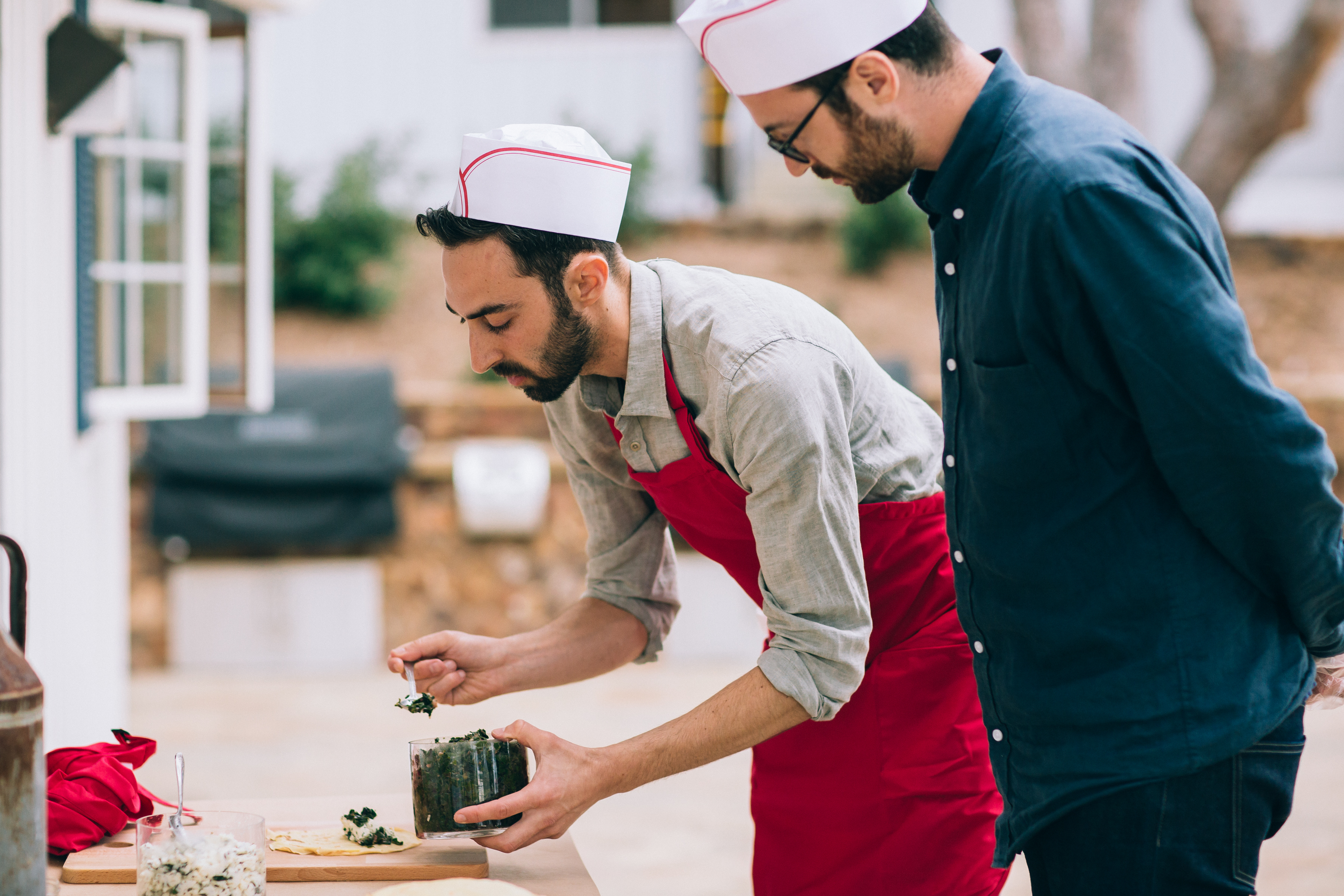 harkening back into the kitchen wisdom of the old world, and bringing both of these moments of Jewish culinary history to life on the coast of California reinforced for me that there’s room to celebrate all of these points on the timeline of folk food traditions. I returned to New York inspired by the farmers who made these meals possible, as well as the reactions of the community to the dishes we’d cooked from The Gefilte Manifesto. I could never have imagined how seamlessly they’d be integrated into the landscape and culture of San Diego.
harkening back into the kitchen wisdom of the old world, and bringing both of these moments of Jewish culinary history to life on the coast of California reinforced for me that there’s room to celebrate all of these points on the timeline of folk food traditions. I returned to New York inspired by the farmers who made these meals possible, as well as the reactions of the community to the dishes we’d cooked from The Gefilte Manifesto. I could never have imagined how seamlessly they’d be integrated into the landscape and culture of San Diego.
Get the Recipe: Lilya’s Summer Beet Borscht from The Gefilte Manifesto
Jeffrey Yoskowitz is the co-owner of The Gefilteria, a culinary venture that reimagines Ashkenazi cuisine, and co-author of The Gefilte Manifesto: New Recipes for Old World Jewish Foods. He fell in love with the art of lacto-fermentation while training as a pickler on an organic farm. He has since worked in the food world as an entrepreneur, consultant, cook, public speaker, and a writer for The New York Times, The Atlantic, Slate, and Gastronomica. He was also featured in Forbes 30 Under 30.
Related Content:
- Boris Fishman: Remaining Russian Through Food
- Stanley Ginsberg: What Is a Jewish Bakery?
- June Hersch: Unraveling the Mysteries of Jewish Food
Jeffrey Yoskowitz is a leader of the Jewish Food Renaissance as the co-founder of The Gefilteria, the celebrated Jewish food venture that reimagines Jewish foods. He curates and cooks pop-up dining events in kitchens around the world, teaches about Jewish cooking and Jewish food heritage, and writes about food and culture for publications like The Atlantic, The New York Times, Slate, and Gastronomica, among others. He was named to the Forbes 30 under 30 list and The Forward 50 and has been featured in The New Yorker, The New York Times, Saveur, and The Wall Street Journal, among many other publications.
